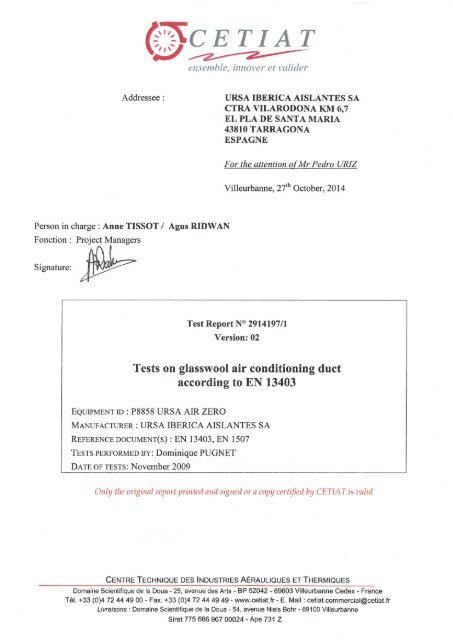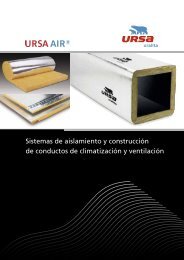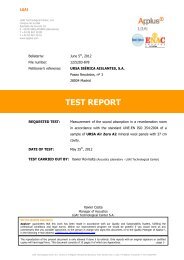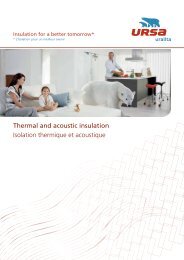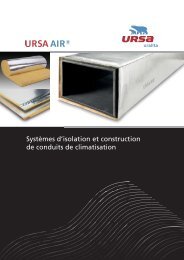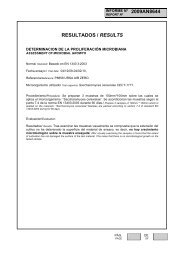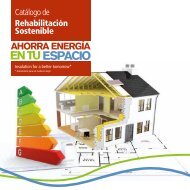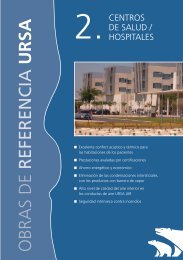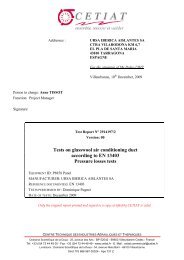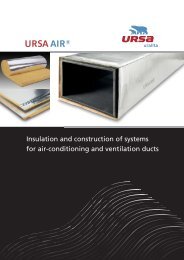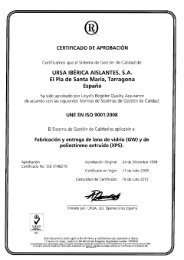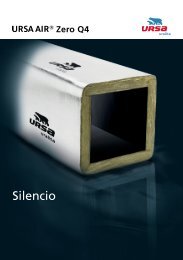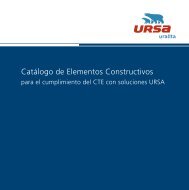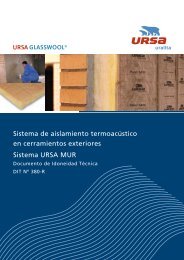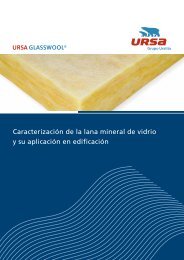Tests on glasswool air conditioning duct according to EN 13403 - Ursa
Tests on glasswool air conditioning duct according to EN 13403 - Ursa
Tests on glasswool air conditioning duct according to EN 13403 - Ursa
Create successful ePaper yourself
Turn your PDF publications into a flip-book with our unique Google optimized e-Paper software.
Test Report N° 2914197/1Versi<strong>on</strong> : 02Cus<strong>to</strong>mer : URSA IBERICA AISLANTES SAThe signed original report cancels all results and draft documents previously submitted.Each updated versi<strong>on</strong> of the report supersedes all previous <strong>on</strong>es.All void copies must be returned <strong>to</strong> CETIAT or destroyed. We draw your attenti<strong>on</strong> of errorsincurred by keeping a void copy.Versi<strong>on</strong> Date Nature of changeModifiedpages00 24/11/2009 First editi<strong>on</strong>01 18/11/2013 correcti<strong>on</strong> of the reference of the pro<strong>duct</strong> 1 – 4 – 502 27/10/2014Update of <strong>air</strong>tightness class based <strong>on</strong> updatedversi<strong>on</strong> of <strong>EN</strong> 1507 standard5 – 12 -13Results of reports are the exclusive property of the cus<strong>to</strong>mer and CETIAT prohibits their distributi<strong>on</strong> <strong>to</strong> thirdparties without prior written c<strong>on</strong>sent.Any commercial use of the name CETIAT or of results is subject <strong>to</strong> CETIAT’s prior c<strong>on</strong>sent.This report may be reproduced <strong>on</strong>ly in its entirety.The reports written by CETIAT are valid <strong>on</strong>ly for the equipment provided for the test in the specificc<strong>on</strong>diti<strong>on</strong>s under which the test was run.Informati<strong>on</strong> c<strong>on</strong>cerning the measurement equipment used for the tests is kept in CETIAT’s archives.The use of these results for designing equipments using this material must take in<strong>to</strong> account manufacturing<strong>to</strong>lerances and real operating c<strong>on</strong>diti<strong>on</strong>s. CETIAT cannot be held liable for such use of these results.The formulas or codes used <strong>to</strong> predict either the operati<strong>on</strong> of a device in c<strong>on</strong>diti<strong>on</strong>s other than those usedin the test or the characteristics of similar devices of different dimensi<strong>on</strong>s are based <strong>on</strong> the state ofknowledge at the time the results were delivered and are subject <strong>to</strong> change. The results obtained throughthese formulas or codes are given as an indicati<strong>on</strong> <strong>on</strong>ly.The original copy of the report is given <strong>to</strong> the cus<strong>to</strong>mer and a certified copy is kept at CETIAT.2/15
Test Report N° 2914197/1Versi<strong>on</strong> : 02Cus<strong>to</strong>mer : URSA IBERICA AISLANTES SAAPP<strong>EN</strong>DIX 1 -REFER<strong>EN</strong>CES<strong>EN</strong> <strong>13403</strong> (2003): Ventilati<strong>on</strong> for buildings – N<strong>on</strong>-metallic <strong>duct</strong>s – Ductwork made frominsulati<strong>on</strong> <strong>duct</strong> boards.<strong>EN</strong> 1507 (July 2006): Ventilati<strong>on</strong> for buildings – Sheet metal <strong>air</strong> <strong>duct</strong>s with rectangularsecti<strong>on</strong> – Requirements for strength and leakage.6/15
Test Report N° 2914197/1Versi<strong>on</strong> : 02Cus<strong>to</strong>mer : URSA IBERICA AISLANTES SAAPP<strong>EN</strong>DIX 2 -EROSION AND EMISSION OF PARTICLESThe samples are arranged in an L-shaped assembly. The entire assembly has similar crosssecti<strong>on</strong>(300 mm × 300 mm).1 : Sucking box2 : Sucking fan3 : C<strong>on</strong>trol valve4 : Absolute filters5 : Blowing plenum7 : C<strong>on</strong>nexi<strong>on</strong> <strong>duct</strong>8 : Duct <strong>to</strong> be testedFigure 2 : C<strong>on</strong>structi<strong>on</strong> for particle emissi<strong>on</strong><str<strong>on</strong>g>Tests</str<strong>on</strong>g> c<strong>on</strong>sisted in :− Purge during 1 h, <strong>air</strong> velocity = 12 m/s,− S<strong>to</strong>p during 15 min,− Erosi<strong>on</strong> test during 5 h, <strong>air</strong> velocity = 18,6 m/s.The particle accounting is made with an optical laser counter with different channels given inTable 1. The counting is not d<strong>on</strong>e during the purge.7/15
Test Report N° 2914197/1Versi<strong>on</strong> : 02Cus<strong>to</strong>mer : URSA IBERICA AISLANTES SAChannelRange1 0,2 – 0,3 µm2 0,3 – 0,5 µm3 0,5 – 0,7 µm4 0,7 – 1,0 µm5 1,0 – 2,0 µm6 2,0 – 3,0 µm7 3,0 – 5,0 µm8 > 5 µmTable 1 : Laser counter rangeThe extracted flow rate is of 28,3 l/min.The average particle c<strong>on</strong>centrati<strong>on</strong> is calculated from the extracted <strong>air</strong> volume and themeasurement of the particle's mass using the following formula :Where :C is the particle c<strong>on</strong>centrati<strong>on</strong> in µg/m 3 ,M is the particles' mass in µg,Q v is the extracti<strong>on</strong> flow rate in m 3 /s.MC =Q tvThe mass of particles is determined from the number of counted particles and the relativedensity of the glass (2500 kg/m 3 ).Figure 3 : View of the inside of the tested <strong>duct</strong>8/15
Test Report N° 2914197/1Versi<strong>on</strong> : 02Cus<strong>to</strong>mer : URSA IBERICA AISLANTES SADetailed resultsDurati<strong>on</strong> of extracti<strong>on</strong> for the optical laser counter : 305 minutesExtracted flow rate for the optical laser counter : 28,3 l/min = 0,0283 m 3 /minExtracted flow : 305 × 0,0283 = 8,63 m 3Volume of a particle (diameter d) =Air velocity in the <strong>duct</strong> : 18,6 m/sAir temperature : 21.3°C < T < 22.8°C34 ⎛ d ⎞×π × ⎜ ⎟3 ⎝ 2 ⎠Range of particlesdiameter (µm)Nb of countedparticlesNb of particles/m 3 Particles mass inµg/m 30,2 - 0,3 3673 426 8.70E0,3 - 0,5 2948 342 2.86E0,5 - 0,7 986 114 3.23E0,7 - 1,0 894 104 8.33E1,0 - 2,0 893 103 4.57E2,0 - 3,0 360 42 8.53E3,0 - 5,0 183 21 1.78E> 5,0 191 22 3.62ETable 2 : Detailed results of the erosi<strong>on</strong> testRequirementsTest resultsParticles > 0,5 µm < 60 µg/m 3 0.007 µg/m 3Particles > 5,0 µm < 4,0 µg/m 3 0.004 µg/m 3Table 3 : Comparis<strong>on</strong> with the requirementsThe material from the inside surface of the <strong>duct</strong>work does not break away, flake off and doesnot show evidence of delaminati<strong>on</strong> or erosi<strong>on</strong>.The requirements c<strong>on</strong>cerning the maximum particle c<strong>on</strong>centrati<strong>on</strong> are fulfilled.9/15
Test Report N° 2914197/1Versi<strong>on</strong> : 02Cus<strong>to</strong>mer : URSA IBERICA AISLANTES SAAPP<strong>EN</strong>DIX 3 -RESISTANCE AGAINST PRESSURE TESTThe pressure test determines the fitness for purpose of the <strong>duct</strong>board assembly. A test sampleis prepared like it can be seen in.A typical rectangular secti<strong>on</strong> <strong>duct</strong>s were c<strong>on</strong>structed by the URSA IBERICA AISLANTESSA company and assembled with a peripheral joint. The used internal secti<strong>on</strong> is 300 mm ×300 mm.A pressure tap is sealed <strong>on</strong> the test sample and c<strong>on</strong>nected <strong>to</strong> a manometer. The manometer ischecked for zero reading at the beginning and end of each test.An <strong>air</strong> supply tape is sealed <strong>on</strong> the test sample <strong>to</strong> supply specified <strong>air</strong> pressure.Figure 4 shows a sample in test.ManometerPressure tapAir inletFigure 4 : View of the test facility10/15
Test Report N° 2914197/1Versi<strong>on</strong> : 02Cus<strong>to</strong>mer : URSA IBERICA AISLANTES SAThe manufacturer's rated pressure is 800 Pa.This pressure is gradually reached in a time between 45 and 60 s, and is maintained during 1min. It is then increased <strong>to</strong> 2000 Pa (2,5 times 800 Pa), and maintained during 1 h.Detailed resultsFixati<strong>on</strong> staples of the peripheral joint did not move during the pressure test.11/15
Test Report N° 2914197/1Versi<strong>on</strong> : 02Cus<strong>to</strong>mer : URSA IBERICA AISLANTES SAAPP<strong>EN</strong>DIX 4 -AIRTIGHTNESS TESTTest is made following <strong>EN</strong> 1507 standard.The test sample built by URSA IBERICA AISLANTES c<strong>on</strong>sists of 7 modules of 1,16 m oflength and secti<strong>on</strong> of 300 mm × 300 mm.Ductwork surface area (A) = 8,15 × 4 × 0,3 = 9,78 m²Total joint length (L) = 6× 4 × 0,3 + 8,15 = 15,35 m.Figure 5: Diagram of the samplesCETIAT closed the ends of the sample with metal sheets.Table 2 shows the <strong>air</strong>tightness classificati<strong>on</strong> defined in the <strong>EN</strong> 1507 standard.Air tightness class Air leakage limit Static gauge pressure limits (Pa)l.s -1 .m -2 Negative PositiveA0,650,027.p test -200 400 (class 1)B0,650,009.p test -500 1000 (class 2)C0,650,003.p test -750 1000 (class 2)D0,650,001.p test -750 1000 (class 2)Table 1: Definiti<strong>on</strong> of the <strong>air</strong>tightness classes – <strong>EN</strong> 1507The limit for the pressure tests is defined by the manufacturer, following the design operatingpressure of the <strong>duct</strong>s.12/15
Test Report N° 2914197/1Versi<strong>on</strong> : 02Cus<strong>to</strong>mer : URSA IBERICA AISLANTES SADetailed resultsAtmospheric pressure : 99600 PaAir temperature : 21.5°CNegative pressurePressure Measured <strong>air</strong>leakageAirflow rateleakage at 20°Cand 101325 PaAirflow rateleakage at 20°Cand 101325 PaAirflow rateleakage at 20°Cand 101325 PaPa Nm 3 /h m 3 /h l/s l/s/m²-52 0.33 0.35 0.10 0.010-100 0.51 0.55 0.15 0.016-204 0.85 0.92 0.25 0.026-352 1.01 1.08 0.30 0.031-509 1.31 1.41 0.39 0.040-756 1.64 1.77 0.49 0.050Positive pressurePressure Measured <strong>air</strong>leakageAirflow rateleakage at 20°Cand 101325 PaAirflow rateleakage at 20°Cand 101325 PaAirflow rateleakage at 20°Cand 101325 PaPa Nm 3 /h m 3 /h l/s l/s/m²98 0.41 0.44 0.12 0.012203 0.68 0.73 0.20 0.021403 1.11 1.20 0.33 0.034608 1.16 1.25 0.35 0.035808 1.36 1.46 0.41 0.0411012 1.61 1.73 0.48 0.049Air leakage rate Air leakage limit class DClass(l/s/m²)(l/s/m²)-756 Pa 0.050 0.074 D1012 Pa 0.049 0.090 DThe sample is in the class D within the limits of positive and negative test pressure.13/15
Test Report N° 2914197/1Versi<strong>on</strong> : 02Cus<strong>to</strong>mer : URSA IBERICA AISLANTES SAFigure 6 : Air leakage rate <strong>according</strong> <strong>to</strong> negative pressureFigure 7 : Air leakage rate <strong>according</strong> <strong>to</strong> positive pressure14/15
Test Report N° 2914197/1Versi<strong>on</strong> : 02Cus<strong>to</strong>mer : URSA IBERICA AISLANTES SAFigure 8 : View of the <strong>air</strong>tightness test plant15/15


